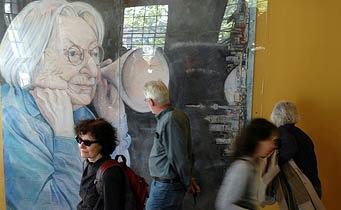“No one can find what will work for our cities by looking at … suburban garden cities, manipulating scale models, or inventing dream cities. You’ve got to get out and walk.”
— Jane Jacobs, “Downtown is for People,” from the book Exploding Metropolis
***
If you are looking for juicy stories about your neighbourhood, check out Jane’s Walk this May. The annual series of walking tours is named after urban activist and author Jane Jacobs, whose life and work had a huge impact on communities and city planning. Jacobs stopped plans for so-called “urban renewal” projects that would have seen expressways rip through neighbourhoods in Manhattan and Toronto. Her grassroots activism and writing helped shift the popular urban planning mindset from one that designs cities for cars to one that focusses on people and community.
Jane’s Walk was created to give people living in an area a chance to tell the history of their own neighbourhood and discuss urbanism. As I recently became involved with Jane’s Walk, I have been thinking more about the importance of urban spaces and the way people view our surroundings.
Last year 6,000 people took part, wandering through 141 neighbourhoods in 11 Canadian cities. This year the event has expanded to 19 cities and towns, and there are several walks that will explore the queer roots of Toronto. Jane’s Walk is an opportunity to see the city through different eyes, to hear stories of the people that lived there before, and to feel that we can share our stories and develop an oral history unique to us. Queer communities have a particularly strong connection to our neighbourhoods because they provide a sense of safety and belonging for so many of us. Although you may think you know your neighbourhood well, Jane’s Walk may very well open your eyes to a rich and diverse history you never knew existed.
I spoke with Jane Farrow, the executive director of the Centre for City Ecology, a group that sponsors and administers the tours. What follows are some of the Toronto-based tours that directly relate to the queer community.
Alongside Gerald Hannon (a central figure in the gay rights movement of Toronto), Farrow leads a “Yonge St is Flaming” historical tour of Toronto gay bars. The tour wanders through locations that were once considered queer hot spots. Farrow recalls an anecdote of a butch-femme dyke scene at the corner of Yonge and Gerrard in the 1950s. She clearly describes a scene where a woman with a duck-tailed hairdo would park her motorcycle in front of the soda shop.
“You can see when people talk about, ‘Were you there?’, ‘What were people wearing?,'” says Farrow. “People realize their anecdotes become part of the history.”
Jed Kilbourn is a Jane’s Walk staff member and liaison with Supporting Our Youth (SOY), which is developing a tour from the perspective of gay newcomers.
“I think queers have had a very interesting history that has largely been oral up until recently,” says Kilbourn. “The younger generation lost a big chunk of our elders, so to participate in something that would allow you to have links to the 1940s and 1950s queer culture, is invaluable.”
Sasha Van Bon Bon is providing a tour of sex work and public sex in Toronto. First offered in 2008, the 12-person limited tour checks out peep shows and dines at the Black Eagle for brunch.
I have the privilege to work with several schools in the Greater Toronto Area. I will be developing walking tours with youth at the University of Toronto Schools, St Jamestown, Sir Sanford Fleming, and the YMCA Academy located at Yonge and Charles. I get to ask youth about their favourite parts of their neighbouhoods, what they would change and why. I plant the seeds of urban planning, and the youth guide tours for the event.
My dear friend Mary has been a fag hag since back in the day and she remembers going to the Music Room where she would sign in as Rita Hayworth in the 1960s. The venue had patrons sign-in because it was a private, members-only club. Mary would tell me about drag queens who worked for weeks on a single number to unveil at the Music Room. Stories like this fascinated me and I always yearned to hear more.
I am looking forward to learning more about and touring through queer spaces in Toronto. I am equally excited to see what Toronto’s students think about community, neighbourhoods and the importance of space in their city.
Jane’s Walk.
Cities and towns across North America.
May 2 & 3, 2009.
For a full list of participating communities, see: www.janeswalk.net.
***
Check out our Google Map walking tours:
Queer Vancouver:
View Larger Map
Queer Toronto – Yonge Street Is Flaming:
View Larger Map

 Why you can trust Xtra
Why you can trust Xtra


